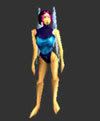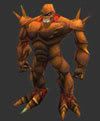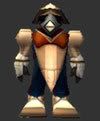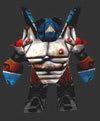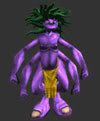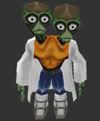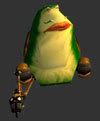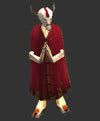The Dahanese Commonwealth is a sovereign nation comprised of an amalgamation of different species displaced by a great war which ravaged their region of space almost two centuries ago. It operates a democratic national government whilst giving extensive powers to its constituent member species, allowing them to keep some semblance of their original governmental organs. Though it has, since its formation almost a century ago, been a minor power, focussing its efforts on reconstruction and economic redevelopment, in recent years it has begun to build up a sizeable defensive force.
Though famous for nothing particularly noteworthy, the Commonwealth is home to a variety of distinct cultures and is well known for establishing recreational space stations all around the universe.
Planetology
Planet Dahan is the capital world of the Dahanese Commonwealth and the homeworld of the Dahanese species. It orbits a type G2 yellow dwarf star called Vel, which is roughly comparable in size, temperature and luminosity to Sol. The planet itself is very similar to Earth in terms of size, mass and atmospheric composition, but it is slightly warmer and has a greater water content, which also means its average humidity levels tend to be higher.
There are three continents, though one is larger than the other two combined and is biased towards the Northern hemisphere. The majority of the population of Dahan originally lived on the western side of this continent close to the equator, where tropical conditions prevail throughout the year. As the population has exploded over the past century, however, it has spread across most of the landmasses.
The zero line of longitude has been established as running through the central square area of Dahania City, with most high density industrialised cities being located to the east, and generally more agricultural and scientific areas and low-density towns and cities to the east. Mining takes place in locations all over the surface of the planet, as well as underwater and on both moons.
Although the planet was largely pollution-free before the establishment of the Commonwealth, with the arrival of industrious species such as Grouliens and Grekka Targ, environmental issues have shot to the forefront.
Physical Characteristics:
Mean Radius: 6,372 km
Mean Circumference: 40,016 km
Surface Area: 764,948,914 km²
Land Area: 107,092,848 km² (14%)
Water Area: 657,856,066 km² (86%)
Mass: 6.0736×1024 kg
Equatorial Rotational Velocity: 493.1 m/s
Orbital Characteristics:
Mean Orbital Distance: 1.0 A.U.
Average Orbital Speed: 31 km/s
Satellites: 1 (Geralos)
Atmosphere:
Pressure: 99.8 kPa (sea level)
Composition: 74.1% nitrogen, 25.21% oxygen, 0.6% argon, 0.029 carbon dioxide, trace water vapour
Environment:
Average Surface Temperature: 43.9 °C
Highest Surface Temperature: 64.9 °C
Lowest Surface Temperature: -21 °C
Environment: Frozen northern pole, small single continent consisting primaril yof rainforest with small temperate zones towards the northeast
Elevation Extremes:
Highest Point: Mount Varmela, 9,312 m
Lowest Point: Lake Seduc, -423 m
Natural Resources:
Iron, silicon, magnesium, nickel, titanium, aluminium, calcium, tin, copper, beryllium, boron, sodium, cobalt, potassium, uranium, carbon (oil & coal), zinc, uranium.
Natural Hazards:
Risk of flooding at all equatorial regions, annual thunderstorms and hurricanes all across the west coasts
Current Environmental Issues:
Arrival of new species to the Commonwealth has caused a sharp escalation in pollution from both mining and manufacturing efforts; Dahanese government taking steps to regulate
International Environmental Agreements:
Strict internal regulation only.
People
The people of the Commonwealth are difficult to categorise; the various species of various origins have, unsurprisingly, varying customs, beliefs, biologies and requirements. Though listed as averages for the most part, these figures do not properly representing the wildly different ages of the numerous Commonwealth species.
Population:
9,260,000,000
Age Structure:
0-14 years: 21%
15-64 years: 77%
65 years and over: 2%
Median Age:
Total: 33
Sex Ratio:
Females 51%
Life Expectancy At Birth:
Total Population: 98 years
Nationality:
Noun: Dahan
Adjective: Dahanese
Ethnic Groups:
Dahanese Sirens 34%, Kasvagorians 19%, Groulien Salt Hogs 15%, Grekka Targ 11%, Greys 8%, Karmaramans 6%, Turrakken 4.5%, Polvakian 1%, Zedem 0.5%
Religion(s):
Dahanism 52%, Atheist 22%, Kasvagorianism 14%, Zedem 12%
Languages:
Dahan (official)
Literacy:
Definition: Age 15 and over can read and write
Total Population: 97% (16/01/14 estimate)
Government
The Commonwealth government is a democratic body with a Dahanese Community Leader at its head, and a Congress of the Nine (so called because each species of the Commonwealth appoints its own representative, making for nine members) serving as both cabinet and unicameral legislature. Government in the Commonwealth is complex, as it tries to allow its individual member species some degree of leeway to maintain the organs of their old governments and laws, whilst still functioning effectively as a cohesive nation and giving each species an equal say. For example, the Greys maintain the ancient Gris High Council, which appoints its leader as the Grey representative to the Congress of the Nine.
Despite these efforts at multicultural government, Commonwealth law always supersedes the laws of individual species.
The current membership of the Congress of the Nine is as follows:
- Community Leader Jess'la (Head of the Commonwealth, Dahanese Community representative)
- Horde-Commander Gruto'tek (Head of Defence, Kasvagorian Empire representative)
- Supreme Commander Maelorn (Head of Health & Welfare, Gris Unity representative)
- Hive Leader Zzksk Vsks (Head of Crime & Punishment, Grekka-Targ Hegemony representative)
- Chief Yakky Gander-Gub (Head of Industry & Commerce, Groulien Star Confederation representative)
- Senior Professors Mordok-Vellen (Head of Science & Education, Turrakken Authority representative)
- Meekua (Head of Agriculture, Karmaraman Commune representative)
- Elder-Monk Velorii (Head of Spirituality, Zedem Conclave representative)
- Lord Vaal (Head of Foreign Affairs, Polvakian Majesty representative)
Country Name:
Long Form: Commonwealth of Planet Dahan
Short Form: Dahanese Commonwealth
Former: Dahan
Government Type:
Representative democracy
Capital:
Dahania
Administrative Divisions:
10 boroughs
Independence:
Dahanese Commonwealth established 55 years ago in Year Zero; previously known simply as Dahan and has been independent for most of recorded history
National Holiday:
Dahanese Commonwealth has no weekends, and instead has three national holidays per week in celebration of life, fertility and pleasure
Constitution:
Formal constitution was ratified by the Congress of the Nine in Year Zero
Legal System:
Civil court
Suffrage:
There is no age of suffrage, as there are no restrictions
Executive Branch:
Head of State: Community Leader Jess'la
Head of Government: Community Leader Jess'la
Legislature/Cabinet: Congress of the Nine
Elections: Annually
Legislative Branch:
Regional Representatives Committee
Judicial Branch:
Dahan Community Court is the highest court of appeal
Flag description:
For the formation of the Dahanese Commonwealth, a new flag was chosen to replace the old Planet Dahan flag, which symbolised love and passion. The new flag is the Dahanese pictograph for 'unity' - symbolising the Dahan belief that no matter your ideology or history, you are welcome in the Commonwealth.
Economy
Since its formation, the Dahanese Commonwealth has undergone a period of rapid transition, as the various new species it had amalgamated into its formerly agrarian society brought with them their own economies. For several years the resultant changes brought devastating recession upon the Commonwealth, for the influx of new people were not catered for by the extant infrastructure.
The Dahan economy of old had relied heavily on the other powers of the region to survive. Previous to the Commonwealth, the Dahans had only ever made any significant income by opening toroid entertainment space stations in foreign lands, which are still seen to this day. It simply wasn't prepared for the massive amount of immigrants that arrived in quick succession.
After several decades of modernisation and reform, however, the new industries were largely assimilated successfully, and overnight Dahan was changed from a quiet farm world and into a bustling planet of many different specialisations. Grouliens, Grekka Targ, Kasvagorians, Turrakkens and the Grey all introduced heavy industries to the Commonwealth, with various different advancements made in the more sophisticated production of advanced technologies. The economy started to become more self-sufficient than it had ever been, as the various 'old economies' of the region were combined into a single - albeit heavily reduced - financial force. Growth began at pace.
Most industry has become highly automated, requiring few workers yet contributing heavily to gross domestic product. Agriculture has become similar, with advanced machines taking over from workers and yet becoming more productive.
Today, though nowhere near amongst the financial giants of the universe, the Dahanese Commonwealth has a respectable marketplace, producing a variety of products and largely possessing a good quality of life. Social reform has attempted to address the disparity between certain species - such as the Greys when compared to the Grouliens - but for the most part, this disparity still exists.
Gross Domestic Product:
$147,022,039,136,513 (^)
GDP Per Capita:
$15,866 (^)
GDP -- Composition By Sector:
Agriculture: 4%
Industry (Inc. Logging): 46%
Retail: 50%
Labour Force:
77% of the total population
Labour Force -- By Occupation:
Agriculture: 1%
Industry (Inc. Logging): 14%
Retail: 85%
Unemployment Rate:
5.6% (\/)
Budget:
Revenues: $110,061,599,542,125 (^)
Expenditures: $104,558,519,565,018 (^)
Agriculture -- Products:
Various native fruits and vegetables
Industries:
Agriculture, tourism, limited mining of various precious gems and practical metals, ship building, communications equipment, computing
Electricity:
Fusion generators supported by microwave solar energy
Currency:
Dahan credit
Military
The Dahanese Commonwealth Militia is the primary defence force of Planet Dahan, comprising of both the army and the navy. It reasonably well-funded organisation that has been slowly rebuilt over the years since the Great Interstellar War, with over four hundred highly advanced warships (of various designs) and tens of millions of active service personnel as of writing. Upon their arrival, the Kasvagorians established a network of defensive exotic particle weapon satellites in orbit around the planet to bolster its survivability, and development to establish a planetary shielding grid is now underway.
The Commonwealth Navy (formerly, and still sometimes known as, the Dahanese Navy) is responsible for the defence of Planet Dahan as well as undertaking any expeditionary missions which may be necessary. Prior to the establishment of the Commonwealth, Dahan had access to only five Dahanese Cruisers, which were unarmed and poorly shielded but quite fast, manoeuvrable and with a large cargo capacity. Once the remnants of the Kasvagorian Empire merged with the Commonwealth, they brought with them ten highly formidable Kasvagorian Annihilators, which are heavily armed and shielded battlecruisers of moderate size, which were added to the Dahanese Navy forces. The Grey Unity brought with them an additional Type 35 Galactic Explorer which was also added to the navy ranks. Military expansion projects have since constructed additional ships of all these classes plus some of Grekka-Targ design, increasing the size of the Navy to its present size.
Additionally, the Kasvagorians made a point of upgrading Dahanese Cruisers with Kasvagorian exotic particle weapons and more powerful shielding systems, making them into quite capable vessels. All Dahanese Cruisers now have a small contingent of Kasvagorian warriors aboard, not only to operate the new Kasvagorian technology now found on the Cruisers, but also to provide general security for the largely pacifistic Dahanese Sirens. Kasvagorian Annihilators are primarily crewed by Kasvagorians themselves, however, with one or two Dahan representatives aboard to act as diplomats. Grey Galactic Explorers are, predictably, crewed primarily by Greys, only rarely hosting a mix of other species aboard as well.
The army has also been rapidly improved. Until the Kasvagorian Horde merged its forces with Dahan there was essentially *no* army at all, which is why the army is still known as the Kasvagorian Horde to this day. In modern times the army has access to over 15,000,000 troops after a significant rise in population and military spend, mostly Kasvagorian warriors with a few tens of thousand Grouliens and Grekka Targ filling in the gaps. They are primarily armed with Kasvagorian particle weapons, although there are a few weapons belonging to the other member species in service as well. An additional 30,000,000 Mark 2 Security Scuzzers have also been deployed throughout the armed forces, which are durable and heavily armed artificially intelligent robots originally of Grey design, capable of fulfilling multiple tasks.
Of late, the Grey Special Assault Force has been rebuilt, based on the original such force from the Grey's earlier times. Although Greys are not especially physically threatening, nor given to violence, the GSAF - consisting entirely of Greys - utilises their highly advanced technologies to turn the Grey soldiers into lethal fighters. Their powered and shielded exoskeletons with stealth technology, when combined with their high degree of intelligence and affinity for ingenuity and stratagem, makes them a dangerous force.
As the Dahanese Commonwealth grows and becomes more involved in universal politics, and as the economy continues to expand, the Militia continues to grow in size and funding. While small compared to some, per capita spend on the Militia is significantly high, affording it decent capabilities regardless of its size.
Military Branches:
CommonwealthNavy
Kasvagorian Horde
Grey Special Assault Forces
Military Age & Obligation:
No obligation. All sentients of the Commonwealth are allowed to join voluntarily from the age of 15.
Current Military Personnel:
Kasvagorian Horde: 15,017,500 (plus 29,980,196 Mark 2 Security Scuzzers)
Grey Special Assault Forces: 129,500
Commonwealth Navy: 11,549,000
Military Expenditures:
$4,182,340,782,600 (^)
History
The history of the Stophiaex Cluster, the region of the galaxy that set the stage for the Great Interstellar War, is extremely long and complex, and much of it has little relevance to the Commonwealth as it presently exists. There are several key facts and events from its more recent history which have a direct influence on the Commonwealth, however, and indeed prompted its formation.
For as long as anybody can remember, the Stophiaex region of the galaxy was dominated by three great powers - the Grekka Targ Hegemony, the Gris Unity (or 'Grey' Unity, in common vernacular) and, most importantly, the Kasvagorian Empire. The Kasvagorians were by far the most powerful of the 'Big Three', and kept the other powers in the region largely at peace - purely through the threat of armageddon. Thus while their neighbours were kept in check, the Kasvagorians were free to expand their large empire beyond the borders of the Cluster, gaining them some recognition in the histories of foreign powers.
At this time the Dahanese were little more than a negligible interest - their franchise of recreational space stations was somewhat popular, and the species itself was often lusted after by slavers, but otherwise they were a non-issue in Cluster politics.
Some 350 years ago however a significant event occurred that would change the political structure of the Stophiaex Cluster beyond all recognition - an extra-galactic foe began a systematic invasion of every power in the Cluster indiscriminately; the Kring Imperium. Possessing technology as advanced as the Gris Unity, and a multitude of ships more powerful even than Kasvagorian Annihilators, the Kring initially operated with impunity in the region, enslaving the Karmaramans and the Grouliens first, before clashing with the Kasvagorian Empire. In them, the Kring found a challenge.
At the onset of the war, the Kasvagorians held the Kring at bay with remarkable efficiency. The highly organised and technologically advanced horde of Kring starships seemed unable to penetrate the line of the Kasvagorian war bands, despite the odds being heavily in their favour. This stalemate continued for two decades, and the numerous battles between the two powers caused horrific damage to the region and the species that inhabited it. The Gris Unity, after putting up an admirable fight, was destroyed with only a few scattered survivors, and the Turrakken Authority was overrun numerous times, each time driven back again by a Kasvagorian war band - these constant battles all but wiped out the two-headed race of scientists.
The Kring appeared to have unlimited resources, while the Kasvagorians could not construct new vessels fast enough to match the invaders head-on. Determined to force the Kring out of the galaxy, the Kasvagorians allied with the Grekka Targ Hegemony and the remnants of the Gris Unity and, with their combined resources, liberated the Grouliens, gaining their alliance as well. After several epic battles, one of which resulted in the complete destruction of an entire planet, the Kasvagorian-Grekka Targ-Groulien alliance, with the assistance of the Grey remnants, engaged the bulk of the Kring fleet at the outer regions of the Cluster.
It was the Kasvagorians who won the battle. By that point, the Grekka Targ Hegemony was a dwindling force, their small empire exhausted from the constant fighting, and the Grouliens had reverted to industrial support. Over three thousand Kasvagorian Annihilators, supported by twenty Grey Galactic Explorers and two hundred Grekka Targ Penetrators, converged on the significantly larger Kring fleet and began a brutal, quick assault. Their first targets were support ships rather than Kring warships, hoping that even if the battle was lost, the destruction of their supplies and hatchery ships would force them to concession, and this campaign was successful. The Grey starships proved to be highly resistant to Kring weaponry and ran interference, drawing a much larger force of Kring away from the main battle and destroying them soundly.
The Kasvagorians took heavy losses. By the time the last Kring vessel was destroyed, believed to be their flagship, only ten Annihilators survived. The Greys lost all but a single vessel, with the remaining Galactic Explorer largely intact, and the Grekka Targ fleet was completely wiped out. But the Kring were gone.
Unfortunately, the entire Cluster lay in cataclysmic ruin. The Kasvagorian Empire had essentially sacrificed itself to destroy the Kring, and the Kasvagorian species itself was threatened with resource shortages, horrific numbers of injuries, and even extinction. The Grekka Targ Hegemony, a large but thinly-dispersed power, had suffered massive casualties and had no fleet left to speak of, and the Gris Unity lay in ruins. Even the lesser powers, such as the Grouliens, the Turrakken Authority, and the Zedem Conclave in particular, had been ravaged by Kring assaults, economic instability, and slavery.
Only the Dahans had been left reasonably unscathed. Their biology offered no particular advantages to the Kring, who were immune to their mood-altering abilities, their military presented no threat, and their planet was largely devoid of appreciable resources or technologies.
Disheartened by the suffering around them, the Dahans first approached the Kasvagorians, who had given so much to defend the region, and proposed something previously unheard of - a unity of the surviving species of the region. They believed that by inviting the remains of the various species of the Cluster to live on the unharmed and fertile Planet Dahan, their combined resources on an untouched world would allow the survival and prosperity of them all. It was to be called the Dahanese Commonwealth.
Whether pressured by their imminent extinction, the threat of future Kring incursions, or perhaps influenced by the Dahanese Sirens' ability to manipulate the moods of others during negotiations, the Kasvagorians shocked the galaxy by agreeing to become one of the original founding members of the Commonwealth. With their martial expertise, Planet Dahan suddenly looked to be a safe-haven, untouched by the war and protected by the Kasvagorians.
Other species flocked to the Commonwealth, and the region suddenly birthed a new major power - one headed by the previously unimportant Dahans.


